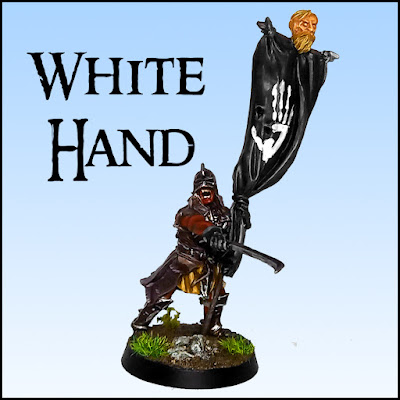135 - Tutorial: Radagast the Brown!
Mae govannen, mellon nín!
Welcome to the final tutorial for the Escape from Goblin Town starter set.
After Bilbo Baggins and Gandalf, the last miniature of this box is the "exclusive limited edition" of Radagast the Brown!
First of all, I must say I didn´t like the characterization of Radagast in the Hobbit films. I found it too comical and idiotic for a Istar, so, I've always had a problem with that (much like with a lot of the dwarves, but those were already addressed).
That said, I think G.W. did an outstanding work with this miniature, aesthetically. There are some issues though: there's some spots of it carelessly undefined (the under-cloak) and the rather complex assembling of the miniature gave me an unnecessary headache.
Nonetheless, the sculpt looks great, and the painting of this miniature was one of the funniest I had with the whole Escape from Goblin Town set!
As usual, and before we get to the description of the character, here follows the list of our painted miniatures from Thorin's Company:
Dwalin | Balin | Thorin Oakenshield | Bilbo Baggins | Gandalf
Who is Radagast?
How to paint Radagast the Brown?
II: The hair and beard of Radagast were basecoat with a light-grey colour;
III: The shading process for the hair and the beard was done with an earth-brown wash;
IV: The highlighting, much like I did with Gandalf's miniature, was achieved with the same light-grey colour used on step II: I tried to pick the most prominent strands of hair on the miniature. The only difference for that of Gandalf is that I stopped here, trying to get the hair and beard greyer and not whiter.
Now, this should come as no surprise, Radagast's cloth plays with different shades of brown, so we have to work with different and contrasting tonalities.
V: First of all, the pants were basecoated with a light sand-toned brown;
VI: The pants were then highlighted with a similar yet lighter tone of brown (a bone-toned brown, as you can see);
VII: To finish the pants, I glazed them with a thinned-down brown wash (this will bring the browns together and give a deeper tone to the recesses);
VIII: I decided to paint the shoes with different colours so, the front shoe (right foot) was basecoated simultaneously with the tunic using a mid-brown.
IX: The shoe and the tunic were then highlighted at two phases. In this first one, I used an Ochre Brown tone (yellower than the colour used for the basecoat);
X: In the second phase of the highlighting of tunic and shoe I used a lighter brown (like a bone tone). Notice that this colour was used only to highlight the fur at the top of the shoe, and not the whole shoe;
XI: Now, as Radagast needs to have a lot of brown tones contrasting with each other, I decided to go for a series of base-coating steps before applying any wash and deeper tones. The first step of this series to basecoat the cloak with a beige-brown (a darker, yet not dark, tone of brown);
XII: The next set of brown basecoats was achieved with a plain dark-brown , used to base Radagast's hat, shoulders and forearm guards (or are that sleeves of a shirt? who knows...).
XIII: The herb satchel was basecoated with a earthy-green paint (you know, a desaturated forest-green);
XIV: I then used a bone-toned brown to basecoat the gloves and highlight the forearms (the hat and the shoulders were also highlighted!!!);
XV: The leaves popping out of the satchel were painted with a rich-green colour (I did not wanted them lighter, but vivid, a strong green tone), without worrying about the highlighting of it since, in a later step, they will receive definition with a brown glaze;
XVI: Then, I basecoated the left shoe and the tiny porcupine (called Sebastian, in the films) with a heavy-grey tone (a furry grey, with a hint of brown to it).
XVII: After all the previous basecoats and minor highlights, it is time to work the robe and the shadows of the browns and the greens. With a sand-brown paint, I lightly drybrushed the beautiful pattern of the cloak (carefully and patiently, so it did not stain the deeper parts of the pattern);
XVIII: With all that, comes the defining step of giving the miniature its shades and blending/glazes. With a thinned-down brown wash, I glazed and gave shadows to the previously painted parts: cloak, gloves, hat, forearms, shoulders, satchel, herbs, and tiny Sebastian. The trick here is to really thin-down the wash and, if necessary, give the mini a second round of washing (just make sure to apply it to the spots its needed);
XIX: The stone of the staff should be painted before the staff itself. I basecoated it with a rich-blue colour, which was mixed with white afterwards, to highlight the stone (I forgot to take pictures of that step);
XX: After the stone, the wood tones of the staff were achieved by base-coating it with a desaturated dark-brown (if you don't have that colour you can add a small hint of blue to your brown). The highlights of the staff were achieved with a mix of the same brown eith a lighter brown (I used the sand-toned brown).
XXI: Finally, Sebastian, the left shoe and the fur of the hat were highlighted with a light-grey colour.
After all these steps, the miniature is ready to be varnished and to have its base finished.
Showcase















Comments
Post a Comment